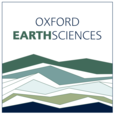Earth Sciences in Conversation: Adina Pusok
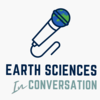
Our Earth Sciences in Conversation series explores the lives and careers of members of the Department, showing readers the people behind our world-leading research. For this issue we sat down with Adina Pusok, Royal Society University Research Fellow in Computational Geodynamics, to learn more about her career journey, her research fellowship, and her favourite type of plate tectonic boundary…
Interview by Charlie Rex
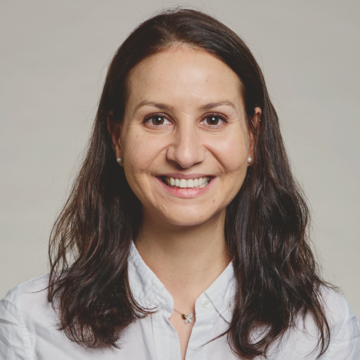
What (or who) inspired you to go into Earth Sciences?
There wasn’t a particular person or a key moment in time that inspired me to choose Earth Sciences – I think it came gradually. Ever since I can remember, I was interested in understanding natural processes. One of the first books that I ever read was a book on clouds: how they form, the different types of clouds, the nomenclature, and that really fascinated me. And then I switched to reading about other topics, like how mountains form and what different geographical regions we have around the world. So over time and coupled with me wanting to do something applied with mathematics and physics, it was a natural progression to go into Earth Sciences. I didn’t fully understand the weight of that decision at the time, but I’m very happy with it because it has meant I have been able to study elements of our planet from a scientific point of view.
Tell us about your university journey, and career path so far
I did an undergraduate degree in Earth Sciences – in Oxford, actually! That was more than 15 years ago. And while initially I thought I would focus on atmospheric processes, I became interested in understanding the mantle and the interior of the Earth. It was the masters project in fourth year that captured my attention, and when I was writing my thesis, I realised I wanted to learn more about those processes. The thesis was on the dynamics of mid-ocean ridges, where two tectonic plates separate and are associated with abundant magmatism. I then progressed to a PhD in Mainz, Germany, where I was trying to understand the dynamics of continental collisions, and why the Himalayas and the Tibetan Plateau are so different from other mountain belts. From there on, I felt that we know little about our planet and more and more questions showed up over time, so from continental collisions I moved to studying subduction dynamics in a research position at the Scripps Institution of Oceanography in San Diego. Finally, just before 2020, my interest in understanding how magma interacts with rocks brought me back to Oxford as a researcher.
You’ve studied every type of plate boundary, which is very impressive! Was there a particular moment during your journey when you decided on a career in academia, or was it more of a gradual process?
It has definitely been a process in discovering whether I enjoy all aspects of research and academia, and I would recommend that to others, because if you don’t enjoy it then maybe an academic career might not be the best option. In my case, I went from one problem to another based on curiosity, and I think I have been fortunate that circumstances allowed me to be driven by that.
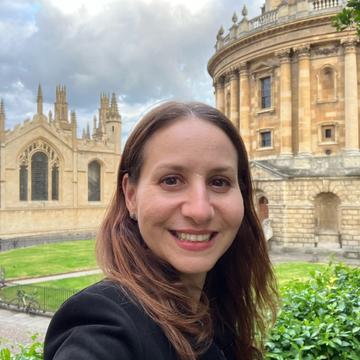
When did your love of maths and physics start?
I loved maths, physics and computer science since school, but I knew from the beginning that I wanted to do something more applied within these disciplines. Nowadays, almost every research field has a component of maths and physics, and maths skills are also in high demand in industry. Maths can get a bad reputation with students, but we absolutely need mathematics for our society, and I wish it didn’t have that reputation.
Lots of your research is centred around theoretical and computer modelling. What do you particularly enjoy about these techniques?
Before we actually run computer models, we describe natural processes in terms of mathematics and physics to create a theoretical description first. Once we have the theoretical description, we can translate it into a computer language, and that’s how a computer model is created. Of course, plenty of my work goes into coding and maintaining various computer models of the Earth, however, the computers are mostly there to help us obtain solutions, so the exciting part is actually building that theoretical model. We're not doing it from scratch, as there’s a lot of existing theory – built up over centuries – that we can draw upon. Modelling is important because even if we have observations, we can only be confident that we understand the processes if we can reproduce them. And theoretical models have this very important property that they're reproducible and are based on physics.
What’s your favourite thing about Oxford?
So many things! It's a beautiful city and has a lot of history, but particularly in terms of research, Earth Sciences is one of the best departments. And that is for a reason – it’s full of very smart people who do very interesting things! I also feel it's very dynamic because people come together to discuss different ideas. I do theoretical and computational work, so I don't need a lot of lab space, but there are lots of resources available and it makes for a great environment to work in. Your curiosity is always stimulated by talks, meetings, coffees, happy hour, so it’s really great. And then not to mention you get to work with some brilliant students. They always ask the best questions and sometimes you have to tell them “I will come back to you because I need to think a bit more about that!”. They’re hard working and I think that’s very inspiring to us as researchers.
https://www.youtube.com/embed/hoBybmiXkzs?si=JQ5nTrAYrwj7y5uXWhat motivates you as a researcher?
Questions we do not yet have an answer for. But surprisingly, I like the routine in trying to address those questions. I do a lot of mental work, and I need to pace it. Of course, there are deadlines that we need to meet and those can be more stressful times. So I think that keeping a routine where I do some work and then I also get to meet colleagues for coffee or to have project meetings, and then at the end of the day to have my quiet space and time, I think that works well. So, even though I like what I do, and sometimes it keeps me awake at night or I think about it during weekends, pacing it in the right way is also important.
What is the proudest achievement in your career so far?
I think there is a tiny proud moment with every publication that comes out. When I received the Royal Society Fellowship, I was extremely happy, but it also came with apprehension about how I was going to demonstrate that work. And I think I’m prouder when I put my work out there for others to critique, to analyse, and maybe to adopt – who knows. So, whenever I publish, those are my proud moments.
You appeared in our Women in STEM series earlier this year. What do you think the value of representation is in Earth Sciences, and have you had any role models?
I think representation is extremely important because people find affinities, and they want to have role models in their lives. My scientific role models have been very important to me - all of them have been men, because there are not that many women in my field! However, I've been fortunate in how supportive they've been, that they allowed me to speak up and say my opinions, and to say what's important and interesting. And I think this is something that we need to promote further. When there are other female students or students from different backgrounds, I think it's very important to give them a voice. It's vital to look at scientific problems from different angles, and sometimes you are surprised how different those angles can be. There are many elements to diversity, and I think it’s very important to include diverse people in scientific discussions.
What would you say to someone just starting out in Earth Sciences research?
I have been thinking about this question quite a lot in the context of what I tell students when I teach. Two things: stay curious and work hard. Staying curious is the one thing that will keep you passionate and determined. And you cannot achieve great things without hard work as well. Sometimes you can be lucky and some things may work out in a spectacular and easy way, but most often it's about hard work. The other advice I have is to read broadly – it helps to stay curious. I like to skim through a whole range of recent articles just to see if something catches my eye. Because if I only read papers on subduction zones or mid-ocean ridges, I would miss some of the exciting developments in other fields that could give me ideas.
What developments in your research field do you think will happen in the next decade?
That's a great question, and I'm curious to look back at my answers in about 10 years’ time! There is going to be a lot of excitement in terms of exploration, both on Earth and in space, and there will be plenty of technological innovations in both directions. I think a major avenue is deep sea exploration. That’s exciting for me because I study tectonic processes in the ocean, and the next decade is going to bring new observations and data from the sea floor, which will allow us to improve our models and understand the processes happening there better.
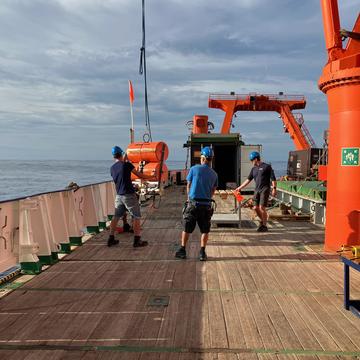
Geophysical instruments such as ocean bottom seismometers (shown in the picture) are deployed to the bottom of oceans at depths as great as 5000 m. These tiny instruments relative to the size of the oceans are powerful windows to the interior of the Earth and its dynamics. Numerical models are then used to help interpret the geophysical observations. Photos taken by A. Pusok during the M204 expedition cruise on the RV Meteor (GEOMAR, DE) in the Atlantic Ocean in October 2024.
Do you have a favourite type of plate tectonic boundary?
Definitely mid-ocean ridges. In my field, people think they're the most boring, but I think they're the most exciting! This is where some of the most fundamental processes on Earth take place – abundant volcanism for example – and we think we have some understanding, but it's not quite there. From a theoretical perspective, mid-ocean ridges are supposed to be a simpler problem that we could solve, so maybe I like mid-ocean ridges because I’m seeking that certainty in understanding them! But there are still open questions, like how we form oceanic crust and what happens at the bottom of tectonic plates.
If you had the chance to go to the top of Everest or the bottom of the Mariana Trench, which would you choose?
I think there is a chance that on top of Everest I wouldn't die instantly, so I choose Everest! But if technology improves, and there is a way to land safely both on top of Everest or the bottom of the Mariana Trench, in terms of interest, it would be very fascinating to see the bottom of the ocean.
What’s your favourite piece of media that involves Earth Sciences?
I love reading, so I'll give a book suggestion! I recently read A City on Mars by Kelly and Zach Weinersmith, which is a great popular science book about all the reasons we're not going to end up colonising Mars anytime soon. The book is technical, but in an approachable, fun way. And I loved it because there is this fascination with the idea that maybe one day we're going to settle on Mars and explore the red planet, but there are some very simple limitations to that, and we don't think too often about those. I think the book is a good wake-up call, that maybe we should look inward at our planet, because we have a beautiful planet and it has plenty of its own mysteries.
What are you currently working on?
I am working on multiple projects – this is the life of an independent researcher! But at the moment, I prioritise writing up a study on whether there might be melt underneath tectonic plates in the oceans. Using a new model of lithosphere cooling, I obtained some results that are quite exciting – and that could potentially explain some recent geophysical observations. The study questions some elements of the plate tectonic theory or the framework in which we operate as Earth Scientists – that the Earth’s outer shell is broken into a number of plates that move relative to each other and on top of a weaker layer. The theory suggests that there should be no magma in the system except at plate boundaries, but recent observations suggest that there might be melt at the bottom of the plates, and the implications of this are quite important because melt could lubricate the base of the plates and impact their motion. With my new models, we predict the stability of melts at the lithosphere-asthenosphere boundary and show that volatiles such as water and carbon dioxide are key ingredients in the system, which links the interior of the Earth back to the oceans and atmosphere and the global volatile cycle. I'm very excited about this project.

